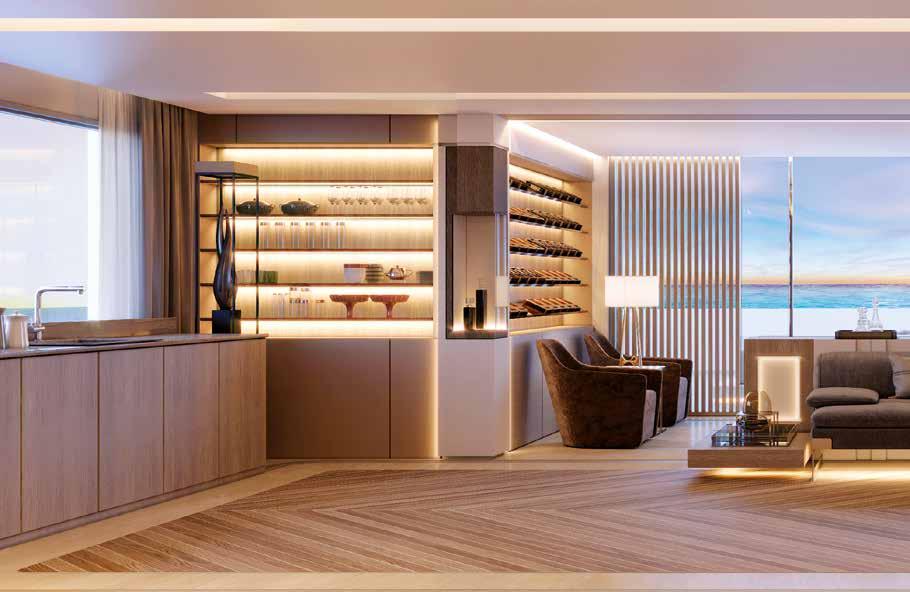
5 minute read
Creative Minds: Luxury Projects
64 Laura Pomponi’s unique designs are the result of constant research and a meticulous selection process. The Benetti FB 273 and Amels 200, on which she is currently working, are prime examples
LIVING IN THE MATERIAL WORLD
Advertisement
The Amels 200. The 60m is due to be launched in 2021 and is the third vessel in the Limited Edition range. Innovative materials, such as cocciopesto and vetrite gem glass, plus a selection of freestanding furnishings lend the interiors an exclusive ambience. Below, the main deck saloon has a natural colour palette and is modern yet very welcoming in style


P” stands for both “Laura Pomponi” and her interior design company, “Luxury Projects” (which is based in the Italian seaside city of Ancona, with offices around the world). But, given that she has been running “LP” for over a dozen years, since branching out on her own, perhaps it’s time to remember the letters’ original meaning: “Long Playing”. The studio’s latest projects are the Italian Benetti FB273, which is due to splash this summer, and the Dutch Amels 200, which is set to launch next year. They are different in that the Benetti is a custom-made project for “a Middle Eastern client who loves art and technology” and the Amels 200 is the third in the Limited Editions range, but “LP” says that both are “modern contemporary projects” that enabled the studio’s design team to “express our creativity.” They involved a lot of work on the lighting, and this meant “prototyping” some lights. The projects also required the LP team to “produce yachts that functioned properly in terms of temperature, while hiding the sources and outlets of the devices.” The air-conditioning grilles, for example, are “invisible”. The Benetti, whose exterior was designed by the yard’s inhouse team, is a 70-metre, but “has everything you would normally find in a 100-metre.” LP already knew the client, having done some residential work for him, but his “attention to detail on this project was such that I had to work pretty hard to gain his trust”. There are four decks: lower, main, sun and upper, which is “L


The lounge area with home theatre on the upper deck of the 70m Benetti FB 273 and, above lefts, the conversation area on the beach club: both are exceptionally refined, modern spaces with a subtle interplay of beige, taupe, grey and white in their colour schemes. Above, sketches of the guest cabins aboard the Amels 200



Laura Pomponi, centre, and her team in the Luxury Projects studio in Ancona (there are offices around the world)

entirely given over to the owner’s “amazing” quarters. They include a large lounge area aft and this has a home theatre. Moving forward, there’s a private office, featuring a glass wall to create “the feeling of space”, a gym and massage cabin, and his-her bathroom. The open cabin is at the front of the deck, and has windows all around. The owner’s guests, on the other hand, will sleep on the lower deck, where there are six cabins. This is the location of the beach club. The guests will also get to hang out with their hosts on the main and sun decks. The former features a large “conventional” reception area, a big salon, and a separate formal dining area that can seat 14. There’s also a lounge area on the sun deck, as well as a jacuzzi. The decks are united by “huge circular staircase.” Throughout this impressive vessel, the recurring colours are beige, taupe, grey and white , all of which are tasteful and gentle on the eye. As for the materials, “we used a lot of bronze, as well as custom-made veneer by Alpi.” As for the 60-metre Amels, even though Laura Pomponi and her colleagues have done many refits in Northern Europe, this was their first new build in The Netherlands. The exterior design was by Tim Heywood and the LP team obviously had less of a role in the compartmentation, but they were still able to add features and finishes to the existing layout in order enhance guest comfort and crew service in. They also
concentrated on innovative materials in order to set the boat apart from others. By the use of loose furniture as much as possible and less or no fixed furniture, the interior became relatively easy adaptable to the taste of the “Final Client”, as one of the main requests in the Shipyards brief was “the possibility of during build customization for the end user”. Happily, the Dutch “were open to the idea of experimentation.” Of particular interest is “the innovative yet ancient cocciopesto”, which is also known by its Latin name, opus signinum. It’s a building material that is “30 per cent less heavy than marble”. The Romans used it for aquaducts, and, in the case of the Amels, it was applied to the showers in the guests’ bathrooms. Other materials include “vetrite” glass, an original liquid metal finish and “beautiful wood” for the floors. The general idea was to use “earthy colours” and to create a feeling that was “neither too bare nor too rich. If an interior is too modern, it’s too bare.” The combination of the materials created a warm interior, the light design and special dome features with indirect light, create a richness and in a way the ability to change the “mood” of the interior by the turn of a switch. In conclusion, LP says that “Playing with materials from the ancient past and near future and influences from different cultures worked especially well. The Yard accepted these concepts and, as a result, a fantastic interior was created.”











